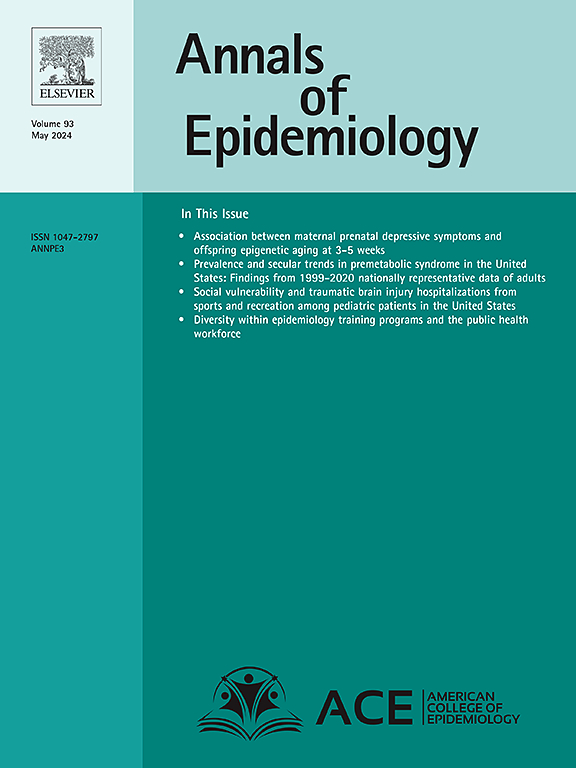丹麦国家患者登记处对ICD-10流感诊断编码的验证。
IF 3.3
3区 医学
Q1 PUBLIC, ENVIRONMENTAL & OCCUPATIONAL HEALTH
引用次数: 0
摘要
背景:在丹麦国家登记中,因流感入院的诊断代码记录的准确性是不确定的。通过与流感检测结果参考标准的比较,评价ICD-10编码对流感的阳性预测值(PPV)和敏感性。方法:在丹麦国家患者登记(DNPR)中评估住院情况,并在丹麦微生物数据库(MiBa)中评估流感检测结果。首先,我们报告了出院流感ICD-10代码(PPV)的住院患者入院后7天内流感病毒检测阳性的比例。其次,我们报告了在流感病毒检测呈阳性(敏感性)7天的住院患者中使用ICD-10流感代码的比例。结果:2012年1月至2022年11月,共有18,761例入院患者登记了DNPR的22种流感ICD-10代码之一。总体而言,16754名入院患者的流感检测呈阳性(87.9% =总PPV, 95% CI: 87.4-88.3)。老年患者组的PPV最高(80岁以下患者为93.7%,11岁以下患者为78.0%),近年入院患者的PPV最高(2022年为95.8%,2012年为52.4%)。在流感检测呈阳性的33,834家入院医院中,不到一半(n=16,421, 48.5% =敏感性(95% CI: 48.0 - 49.1%))登记了流感ICD-10代码。结论:ICD-10诊断代码具有较高的阳性预测值,但敏感性较低。此外,PPV取决于年龄和日历年。最新消息:本文章由计算机程序翻译,如有差异,请以英文原文为准。
Validation of ICD-10 diagnostic coding for influenza in the Danish National Patient Registry
Background
The accuracy of recorded diagnosis codes for hospital admissions due to influenza in the Danish national registries is uncertain. We evaluated positive predictive value (PPV) and sensitivity of ICD-10 codes for influenza by comparing to the reference standard of influenza test results.
Methods
Hospital admissions were assessed in the Danish National Patient Registry (DNPR), and influenza test results in the Danish Microbiology Database (MiBa). First, we report the proportion of positive influenza virus tests within seven days of admission among hospital admissions with a discharge influenza ICD-10 code (PPV). Second, we report the proportion with ICD-10 codes for influenza among patients with an admission registered with seven days of a positive influenza virus test (sensitivity).
Results
From January 2012 – November 2022 a total of 18,761 admissions were registered with one of the 22 influenza ICD-10 codes in DNPR. Overall, there was a positive influenza test in 16,754 of the admissions (87.9 % = overall PPV, 95 % CI: 87.4–88.3). The PPV was highest for older patient groups (93.7 % in patients >80 years vs. 78.0 % in patients < 11 years), and for admissions that occurred in recent years (95.8 % in 2022 vs. 52.4 % in 2012). Among 33,834 hospitals admissions with a positive influenza test, less than half (n = 16,421, 48.5 % = sensitivity (95 % CI: 48.0 – 49.1 %)) were registered with an influenza ICD-10 code.
Conclusions
ICD-10 diagnoses codes have relatively high positive predictive value, but the sensitivity is low. Furthermore, the PPV depend on age and calendar year.
What is new
- •Danish national registries have reasonable positive predictive value for influenza ICD-10 codes.
- •Positive predictive value varies with time of hospital admission and age of the patient.
- •Studies based on ICD-10 codes alone underestimates the number of patients with influenza due to low sensitivity.
求助全文
通过发布文献求助,成功后即可免费获取论文全文。
去求助
来源期刊

Annals of Epidemiology
医学-公共卫生、环境卫生与职业卫生
CiteScore
7.40
自引率
1.80%
发文量
207
审稿时长
59 days
期刊介绍:
The journal emphasizes the application of epidemiologic methods to issues that affect the distribution and determinants of human illness in diverse contexts. Its primary focus is on chronic and acute conditions of diverse etiologies and of major importance to clinical medicine, public health, and health care delivery.
 求助内容:
求助内容: 应助结果提醒方式:
应助结果提醒方式:


